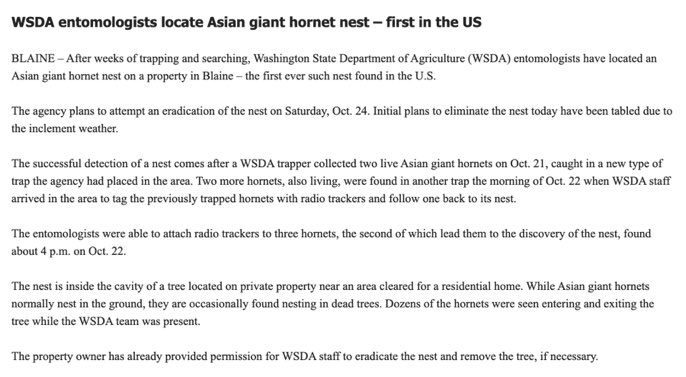Washington State entomologists have successfully used radio trackers to locate the US’s first Asian Giant Hornet nest.
In August, I wrote about the race to find the nest before bee-beheading season, and how DNA sequencing might help:
https://www.wired.com/story/inside-the-sprint-to-map-the-murder-hornet-genome/amp">https://www.wired.com/story/ins...
In August, I wrote about the race to find the nest before bee-beheading season, and how DNA sequencing might help:
https://www.wired.com/story/inside-the-sprint-to-map-the-murder-hornet-genome/amp">https://www.wired.com/story/ins...
Also, whoever is writing the WSDA stakeholder updates is killing it. From Oct 7: "Three methods were attempted: super glue, double-sided tacky tape, and floss. Tying on the tracker with floss seemed to be the most successful. However, in the end the hornet was unable to fly."
"Several factors could have contributed, but the most likely cause was a small amount of glue that smeared on its wings from when the tracker slid off the hornet during the initial gluing attempt."
From Oct 12: "The hornet was taken out of the cooler briefly and fed strawberry jelly, which it seemed to like. It was then again placed in the cooler to keep it calm until the next day."
"WSDA returned to the site and Vikram Iyer, a researcher from the University of Washington came and brought new trackers. Activities of the day began later than planned due to heavy fog in the area."
"As the team waited for the fog to lift, several neighbors came to watch the activities. Vikram advised those who had gathered that they could download an app to track the hornet using the Bluetooth feature on their cell phones."
"Several neighbors downloaded the app in anticipation of helping track the hornet. Once the tracker was attached, the hornet was placed in a container and allowed to warm up."
"Based on suggestions from European counterparts dealing with a similar species, the hornet was placed in an apple tree (rather than the ground) as this allows hornets to take off from an elevated location."
"The hornet warmed up and crawled on an apple, groomed itself, and then took flight. The team and neighbors tracked the hornet from tree to tree for about an hour before losing her signal in the forest."
"Both staff and several neighbors spent the remainder of the afternoon searching the area for the tracking signal (which would transmit for approximately 12 hours) but, unfortunately, it could not be located."
"It was determined that radio transponders with a longer range and battery life would be extremely beneficial for future attempts and they have already been ordered."
This might be weird to admit, but I have really looked forward to these updates. There& #39;s something about their wholesome, pragmatic accounting of invasive insect drama of the highest order that I have found immeasurably charming and comforting.

 Read on Twitter
Read on Twitter


